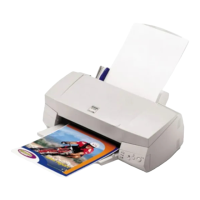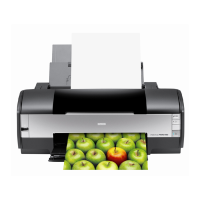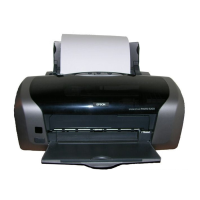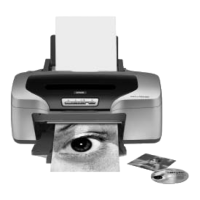EPSON Stylus Photo 925 Revision A
Operating Principles Electrical Circuit Operating Principles 48
2.2.2.5 Sensor Circuit
This printer is equipped with some types of sensors to detect various printer conditions.
The major sensors are as follows:
T PE Sensor
T CT Sensors (Home-80/Home-0)
T Thermistor in Head
T CR Encoder
T PF Encoder
In the same way as the previous printer model, this printer employing DC motors as driving sources
uses the CR encoder and PF encoder. The other sensors are the same types as those for the
conventional printer models. Figure 2-26 below shows the outline of the sensor circuit.
Figure 2-26. Sensor Circuit
The functions and detecting principles of the sensors are as follows:
V PE Sensor
This sensor, using a photo-interrupter system, consists of the photo-interrupter
components and detection lever. This sensor outputs the LOW signal when there is
paper in the paper path. This sensor outputs the HIGH signal when there is no
paper in the paper path. This condition is always monitored with this sensor while
the printer power is turned on.
V CT Sensors (Home-80/Home-0 detectors)
These sensors, mounted at both ends of the cutter travel region, use the photo-
interrupter system. Each sensor outputs the HIGH signal at presence of the Cutter
CR but the LOW signal at absence of the Cutter CR. Combinations of the signals
from the two sensors represent various states of the Cutter CR. Table 2-12Table
below indicates the combinations of the two signals.
V Thermistor (THM)
The thermistor is attached directly on the print head driver board. It monitors the
temperature around the print head and determines the proper head drive voltage
according to the ink viscosity that varies by the temperature. The temperature
detected by the thermistor is returned to the CPU analog port. When the
temperature rises, the head drive circuit lowers the drive voltage: When the
temperature lowers, the head drive circuit rises the drive voltage.
V CR Encoder
The CR Encoder consists of the transmission type photosensor mounted on the
carriage and the linear scale mounted in the carriage running direction. It has the
maximum resolution of 1/180 inch and outputs to the CPU the High signal through
a black slit on the linear scale and the Low signal through a transparent slit. The
CR Motor is controlled based on these output signals. This sensor detects also the
carriage home position.
CPU (IC11)
E01A27CA
ENCA_PFDCU
ENCB_PFDCU
ENCA_CRDCU
ENCB_CRDCU
SWA0
SWA1
SWA2
C_P42
VCC
GND
GND
ENA
ENB
ENA
ENB
EVDD
GND
GND
PEV
GND
PE
Head FFC CN8
PE Sensor CN10
CR
EncoderCN10
PF EncoderCN12
+3.3V
C167
+3.3V
+5V
C168
R189
+5V R161
R166
R165
THM
C_P43
R162
R229
+3.3V
VC1
CT1
GND
VC2
CT2
GND
CT Sensor CN15
Table 2-12.Combinations of Both Signals
Cutter
Home-80
Detection
Cutter
Home-0
Detection
Cutter Status
Required
Operation
Printer Status
Presence Absence Normal - Printer operation OK
Presence Presence Abnormal
Cutter return
operation
required
Cutter is faulty if the same state
is kept even after return
operation
Absence Absence
During cutting
or paper jam
Absence Presence
Cutting end or
paper jam
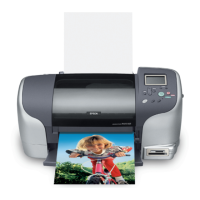
